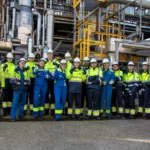
30 million tonnes of plastic waste is collected every year in Europe, still 85% of that ends up in landfill, in incineration or is exported. At a recent digital dialogue we gathered a panel of experts to discuss how chemical recycling could play a role in solving this issue.
“We need to make sure we don’t only collect and recycle, but we also bring the recycled materials back to the economic cycle, to the new products”, said Rana Pant, Policy Officer Single Use Plastics (SUP) & country responsibilities on Waste Management, DG Environment, European Commission.
Sharing how France is addressing the issue Olivier Stemler, Projects Director Chemistry, Water, Biotechs, French Ministry of Economy, Finance and Recovery, highlighted that the national goal is to foster recycling technologies: “The French public authorities together with different stakeholders of the industry are also putting in place, for two years, a national plan to remove the regulatory obstacles to boost plastic recycling, as an example of how we can move forward”. To fund these circularity projects, France is allocating 500 million euros from the national recovery fund.
The role of chemical recycling in helping tackle plastic waste
Chemical recycling can compliment mechanical one since chemical recycling can treat mixed and contaminated plastic waste that cannot be recycled mechanically. That’s how Inari Seppä, Director of Circular Economy Advocacy at Eastman, defined the role of this technology. “These technologies have truly a potential to create an infinity loop for plastics, maintaining the raw materials in circulation again and again. There is no compromise on performance or quality, and safety of the products that are made with those raw materials”, Seppä said. Recycling targets for some products is now creating a market for chemical recycling, but collaboration along value chains and creating more incentives for this technology are needed to increase its uptake.
According to Youssef Chtourou, Global Circular Economy Director of Packaging at Danone, we need innovation to offer options to consumers beyond single use-consumption. We need innovation from materials and innovation on recycling: “Chemical recycling can play a role enabling the recycling of plastics that are not recycled today, but also offer brand owner, like Danone, the possibility to integrate this plastic in our production, as an alternative to fossil conversion plastics”, he stressed. At the same time, it is important to ensure that we only need chemical recycling for something that cannot be recycled mechanically. “And we need to ensure what is the environmental impact of chemical recycling technologies, and how they compare to virgin plastics”, he added.
Supporting regulatory framework is crucial for circular technologies

The panel also discussed the role of regulation and agreed that a comprehensive legal framework that establishes a clear definition of recycled content and chemical recycling technologies is crucial for investments. Rana Pant emphasised that chemical recycling is currently not captured by the existing Waste Framework Directive, but this could change with the upcoming revision in 2023.
The panel also discussed the role of regulation and agreed that a comprehensive legal framework that establishes a clear definition of recycled content and chemical recycling technologies is crucial for investments. Rana Pant emphasised that chemical recycling is currently not captured by the existing Waste Framework Directive, but this could change with the upcoming revision in 2023.
“How we produce plastics, how we use plastics, but also how we manage plastics at the end of their life are very important questions”, said Janek Vähk, Climate, Energy and Air Pollution Programme Coordinator at Zero Waste Europe, who also stressed the need to focus on different recycling technologies, to clarify the legal status of chemical recycling and recovery, and to have a clear definition on what they are, and in which categories they can be put. From his perspective, “we need to focus on improving the actual recyclability of plastics. Keeping the value of plastics in the economy as long as possible is crucial”. Vähk called for a standardised methodology to calculate the climate impact of chemical recycling and a consistent framework for that.
Finally, the panel agreed that sorting of waste should also be addressed appropriately, and that consumers seem to recognise the value of bringing materials back. Collecting and sorting plastic waste are important steps before being directed to specific recycling solutions. “Dialogue and collaboration are really needed. How do we best get the plastic waste that we see in the environment to one place where it can be then used?”, highlighted Seppä.
Chemical recycling facilities are already operational
Chemically recycled plastics is already in use in multiple applications, from food packaging products, to refrigerator and cars parts, mattresses, etc. Cefic members are running several projects in different member states across Europe. According to Daniel Witthaut, Cefic Executive Director Innovation, “the industry’s focus is to scale up to an industrial level, integrate chemical recycling technologies into the industry operation and develop product applications with value chain partners”.
Some examples of what is happening on the ground are part of the online exhibition “Chemical Recycling: Making Plastics Circular”.










